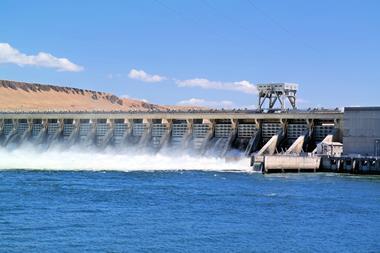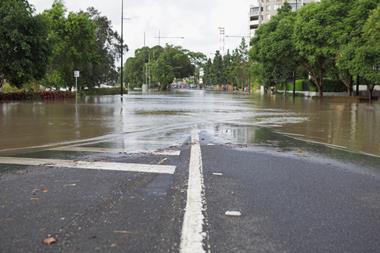The Environment Agency has launched a long-term strategy to tackle flooding and coastal change
Flood Re has reaffirmed its commitment to work with the insurance industry and the UK government to tackle the issue of flooding in England, and ensure that those living in a high flood risk area can access affordable and available cover.
It follows the Environment Agency (EA) launching its long-term strategy to tackle flooding and coastal change. It is proposing that all infrastructure should be resilient to flooding and coastal change by 2050. It has estimated that this would take £1bn on average per year to achieve this.
Plans
Andy Bord, chief executive at Flood Re, told Insurance Times: “Flood Re welcomes the Environment Agency’s new long-term strategy to tackle flooding and coastal change which aligns with our own long-term goals and plans. The £1bn a year of investment is essential. The strategy’s recognition of the vital importance of flood resistance and resilience for the UK’s housing stock – to reduce both the overall number of homes flooded and the damage where flooding does occur – echoes a key aspect of our own ’Transition Plan.’
He cited that Flood Re has so far helped more than 200,000 households get affordable insurance. In its second transition plan which is a joint initiative between the UK insurance industry and the UK government, it builds on the firm’s initial work while setting out a vision for reducing flooding.
So far it has raised awareness of the scheme and the importance of insurance through roundtables, helped society understand the nature and scale of flood risk and how to mitigate them through projects like “Local Heroes,” as well as engaging with the insurance industry, parliamentarians, academics, flood experts and stake holders.
Launched in 2016, Flood Re was initially funded by the insurance industry. It offers and promotes the availability of affordable flood insurance and will operate until 2039.
Flood Re’s vision
1. Limit the risks of flooding
- Investing in flood risk management and defences
- Development with flood risk in mind
2. Reducing the damage and costs of flooding
- Improving property flood resilience and resistance products
- Increasing the overall flood resistance and resilience of the UK’s housing stock
- Improving the operation of community flood resistance and resilience
- Reducing the cost of reinstatement
3. Achieving an effective market
- Improving flood modelling
- A smooth Flood Re exit
- Improving consumer information on flooding and the value of insurance
- Active engagement in the market
4. The limits of affordability
- Those with unavoidably high levels of flood risk
- Minimising the size of the highest-risk group
Long-term Strategy
In its plan the EA said it is preparing for a four degree rise in global temperature as well as population growth set to double the number of properties built in flood plains over the next 50 years.
It advocated that the UK needs a number of resilience tools to help avoid and recover from flooding. This includes effective use of insurance to transfer costs between parties.
It cited a key problem – that most insurance companies will not pay to replace flood-damaged items with stronger flood-resilient products. The EA said if this was changed in insurance policies it would make resilience within reach, it urged insurers to incentivise customers who are at risk of flooding.
The EA stated that it will develop new standards of flood resilience for communities, with the intention of making all infrastructure resilient by 2050. This will see the EA open an eight-week consultation on the new strategy up until 4 July. Its chair Emma Howard-Boyd said “you cannot win a war against water” by building higher flood defences and called for a new approach. She said that urgent action is needed to mitigate more frequent, intense flooding and sea levels rising.
It has committed to working with partners to develop consistent standards for floods and coastal resilience across the UK. At present two thirds of properties in England are served by infrastructure in areas at risk of flooding and for every person who suffers flooding, around 16 more are affected by loss of services such as power, transport and telecommunications.
The report estimated that although by 2070 average summer rainfall could decrease by up to 47%, winters could possibly be wetter with 35% more precipitation.
It cited that 700 properties in England are vulnerable to coastal erosion over the next 20 years, and the 5.2 million homes and businesses in England are at risk of flooding with numbers set to increase.
No cause for complacency
The Association of British Insurer’s (ABI) has warned of the “potentially drastic consequences” for homes, businesses and communities if action against is not taken.
Huw Evans, director general at the ABI, said: “At least one billion pounds a year to bolster physical defences is essential to support the Environment Agency’s plan to protect vital infrastructure as well as property.
“A lack of major floods in recent years is no cause for complacency. As well as building defences we need to increase awareness of flood risk and encourage home and business owner to put in place their own measures to protect their properties too.”
Redoubling efforts
Nicolas Aubert, head of Great Britain, WTW commended the EA’s approach on the matter.
He said: “The financial sector must redouble its efforts to address climate risks and, working with the public sector, support the investment and other interventions needed to deliver national and local resilience, now, and in the decades ahead.”
Sir John Armitt, chair of the National Infrastructure Commission also welcomed the approach. He said: “In many cases, we won’t be able to stop flooding and coastal erosion. But that doesn’t mean we should just accept it. We must ensure that communities are resilient and as our Assessment showed, this is affordable and achievable.”
Success factor?
Jonathan Guard, director, Commercial Markets, at LexisNexis Risk Solutions UK, told Insurance Times: “Only a very small percentage of the 5m properties at risk of flooding have been made flood resilient. Although government spending in the last 20 years has been very much focused on flood defences, a 4°C rise in global temperature will mean that many of the flood defences currently in place will fail, and properties thought to be protected will once again be at risk. An adjustment in emphasis to focus more on the resilience of a property to withstand flooding is a significant change in policy, and will have consequences for both property owners and the insurance industry.
“With Flood Re eventually going to be phased out and replaced by risk-reflective pricing, the insurance industry will need to be able to differentiate those properties which are protected from flooding (whether by defence or resilience measures) from those at risk. It will need new tools and data, as well as a new certification process, so that insurers can assess the level of protection and the level of risk that they are absorbing for future claims.
He said that the insurance industry can also expect other potential perils risks from a 4°C rise in global temperature, including more severe storms and colder winters, leading to a range of property damage claims; storm damage, subsidence claims, freeze and escape of water claims.
The government’s National Infrastructure Strategy is to be published this autumn as part of the spending review. Armitt hopes it adopts the recommendation.
The EA will present a final document before parliament in winter this year.
Subscribers read more
Subsidence claims surge pushing home insurance premiums but is there more to it













































No comments yet